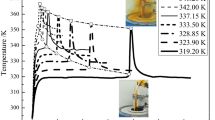Abstract
The article is devoted to a comparative study on the thermal degradation of some new diazoaminoderivatives under both air and nitrogen atmosphere by TG-FTIR analysis. The TG–DTG–DTA curves show the thermal degradation in air to present two temperature domains: an endothermic one identical to the case of the degradation under nitrogen and an exothermic one which is not to be found under nitrogen atmosphere. The identification of the gaseous species released by degradation in air within the endothermic domain made evident the presence of the same components of the degradation in nitrogen atmosphere. In the exothermic domain of the sample degradation in air, the CO2, H2O, SO2 species result by the burning of the molecular residues of the first domain. The obtained results afforded a degradation mechanism to be advanced that coincide for the endothermic domain with that of degradation under nitrogen atmosphere. Due to the importance of these compounds as possible reaction initiators and also as potentially bioactive substances (herbicides, acaricides, fungicides), the study on their thermal degradation could give useful information on the environmental impact of the degradation products resulting by the thermal processing of the plants which could possible retain these compounds, when the initial degradation temperature is exceeded.









Similar content being viewed by others
References
Odochian L, Mocanu AM, Moldoveanu C, Carja G, Oniscu C. Study by thermal methods on some new hydrazinic complexes. J Therm Anal Calorim. 2008;94:329–34.
Mocanu AM, Odochian L, Carja G, Oniscu C. Study on thermal behavior of some new diazoaminoderivatives. Roman Biotechnol Lett. 2008;13(6):3990–8.
Mocanu AM, Odochian L, Moldoveanu C, Carja G, Oniscu C. Study by thermal methods on some new hydrazinic complexes. Rev Chim. 2009;60:928–33.
Mocanu AM, Odochian L, Apostolescu N, Moldoveanu C. TG-FTIR study on thermal degradation in air of some new diazoaminoderivatives. J Therm Anal Calorim. 2010;100:615–22. doi:10.1007/s10973-009-0005-8.
L. Odochian, M. Dumitras, Teoria cinetica si mecanismul reactiilor in lant. I Reactii in lant simplu, Ed. Matrix ROM, Bucuresti; 2003. p. 38.
Díaz JA, Vega S, Expósito MA, Sánchez Mateo CC, Darias V. Synthesis and antidepressant evaluation of new hetero[2, 1]benzothiazepine derivatives. Arch Pharm. 1996;329(7):352–60.
Hollay KL, Kookana RS, Noy DM, Smith JG, Wilhelm N. Persistence and leaching of sulfonylurea herbicides over a 4-year period in the highly alkaline soils of south-eastern Australia. Aust J Exp Agric. 2006;46(8):1069–76.
Hollay KL, Kookana RS, Noy DM, Smith JG, Wilhelm N. Persistence and leaching of imazethapyr and flumetsulam herbicides over a 4-year period in the highly alkaline soils of south-eastern Australia. Aust J Exp Agric. 2006;46(5):669–74.
Strebe AT, Talbert ER. Sorption and mobility of flumetsulam in several soils. Weed Sci. 2001;49(6):806–13.
Jabusch TW, Tjeerdema RS. Partitioning of penoxsulam, a new sulfonamide herbicide. J Agric Food Chem. 2005;53:7179–83.
Odochian L. Study of the nature of the crystallization water in some magnesium hydrates by thermal methods. J Therm Anal Calorim. 1995;45(6):1437–48.
Odochian L, Dulman V, Dumitras M, Pui A. Study by thermal methods on the materials obtained by dye removal from waste waters with beech flour. J Therm Anal Calorim. 2007;89(2):625–31.
Dumitras M, Odochian L. Study on the influence of PTFE particle size on the polymer thermal behavior: I. Melting. J Therm Anal Calorim. 2002;69(2):599–606.
Jie L, Yuwen L, Jiugyan S, Zhiyoug W, Ling H, Xi Y, Cunxin W. The investigation of thermal decomposition pathways of phenylalanine and tyrosine by TG-FTIR. Thermochim Acta. 2008;467(1–2):20–9.
Chuang FS. Analysis of thermal degradation of diacetylene-containing polyurethane copolymers. Polym Degrad Stab. 2007;92(7):1393–407.
Barrall EM. Precise determination of melting and boiling points by differential thermal analysis and differential scanning calorimetry. Thermochim Acta. 1973;5(4):377–89.
Nenitescu CD (ed). Chimie organica, vol I. Bucuresti: Didactica si Pedagogica; 1974. p. 584, 601.
Whitely N, Ozao R, Cao Y, Pan WP. Multi-utilization of chicken litter as a biomass source. Part II. Pyrolisis. Energy Fuels. 2006;20:2666–2671.
Pawlowski KH. Wirkungsmechanismen von Bisphenol-A-bis(diphenylphosphat) als Flammschutzmittel in Polycarbonat/Acrylnitril-Butadien-Styrol-Copolymerisat. BAM-Dissertationsreihe Band 33, Berlin; 2008 (ISBN 978-3-9812072-3-1).
Schonherr R. TG-FTIR Atlas Elastomere. D-Burgdorf: Verlag W.KSchonherr; 1996.
Walter D, Buxbaum G, Laqua W. The mechanism of the thermal transformation from goethite to hematite. J Therm Anal Calorim. 2001;63(3):733–48.
Opfermann JR. Kinetic analysis using multivariate non-linear regression. I. Basic concepts. J Therm Anal Calorim. 2000;60(2):641–58.
NIST Chemistry Webbook. 2005. NIST Standard Reference Database number 69. http://webbook.nist.gov/chemistry.
Author information
Authors and Affiliations
Corresponding author
Rights and permissions
About this article
Cite this article
Mocanu, A.M., Odochian, L., Apostolescu, N. et al. Comparative study on thermal degradation of some new diazoaminoderivatives under air and nitrogen atmospheres. J Therm Anal Calorim 103, 283–291 (2011). https://doi.org/10.1007/s10973-010-0857-y
Received:
Accepted:
Published:
Issue Date:
DOI: https://doi.org/10.1007/s10973-010-0857-y




